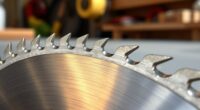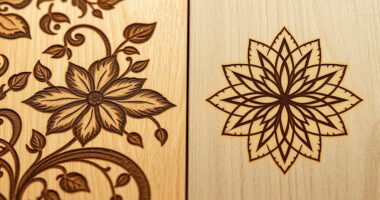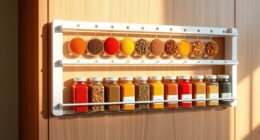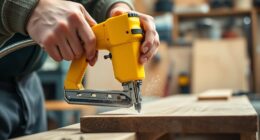To guarantee your wood stove is safe, prioritize proper ventilation by checking that your chimney and vents are clear of debris and functioning correctly. Regularly inspect and clean your chimney and dispose of cooled ashes in a metal container away from your home. Installing carbon monoxide detectors adds safety, while maintaining good airflow prevents smoky buildup and dangerous gases. Keep these precautions in mind—your home’s safety depends on it, and you’ll discover more tips if you keep going.
Key Takeaways
- Ensure chimney inspections and cleanings are performed annually to prevent creosote buildup and fire hazards.
- Maintain proper ventilation by checking dampers and clearing vents to safely exhaust smoke and harmful gases.
- Use a metal container with a tight lid, and fully cool ashes before disposal to prevent accidental fires.
- Install carbon monoxide detectors and ensure ventilation systems are functioning correctly for indoor safety.
- Address damage or blockages promptly in chimneys, vents, or flues to reduce fire risks and improve heating efficiency.
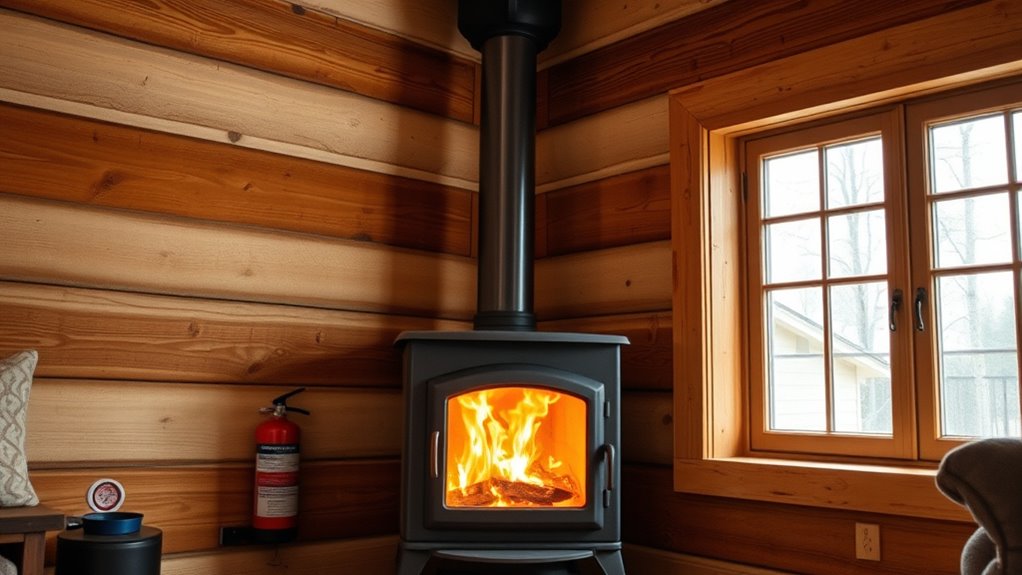
Using a wood-burning stove or fireplace can create a warm, cozy atmosphere, but it also comes with safety risks if not handled properly. One of the most important safety measures involves regular chimney maintenance. Over time, creosote and soot build up inside your chimney, increasing the risk of dangerous chimney fires. You should schedule annual inspections and cleanings with a professional to guarantee your chimney remains free of obstructions and buildup. If you notice any signs of damage or blockages, address them immediately to prevent smoke or harmful gases from entering your living space. Proper chimney maintenance not only enhances safety but also improves the efficiency of your heating system, helping you conserve fuel and reduce emissions. Additionally, using safe materials for your fire can prevent dangerous flare-ups and smoke production.
Another critical aspect of safe wood-burning is ash disposal. As you burn wood, ash accumulates and needs to be removed regularly. It’s essential to dispose of ash safely because hot embers can remain hidden in the ashes for days, posing a fire risk if not handled carefully. Always use a metal container with a tight-fitting lid for ash disposal, and keep it away from your home, garage, or any combustible materials. Make sure the ashes are completely cooled before you transfer them to the container; you can do this by letting them sit for at least 48 hours. Never dump ashes directly into a plastic bag or paper trash bin, as this can ignite and cause a fire. Proper ash disposal minimizes the risk of accidental fires and keeps your home safe.
Ventilation is equally crucial when using a wood-burning stove or fireplace. Adequate airflow ensures that smoke and harmful gases like carbon monoxide are properly vented outside, preventing dangerous indoor air quality issues. Make sure your chimney’s damper is functioning correctly and opens fully when you start a fire. Keep vents and flues unobstructed by debris or nests, and consider installing carbon monoxide detectors in your home. Good ventilation also helps the fire burn more efficiently, producing less creosote and reducing smoke buildup. Ignoring ventilation needs can lead to a buildup of harmful gases, which can cause health problems or even pose a risk of poisoning.
Frequently Asked Questions
How Often Should Chimney Flues Be Inspected and Cleaned?
You should schedule chimney maintenance and flue inspection at least once a year to keep your chimney safe and efficient. During the off-season, check for creosote buildup, blockages, or damage. Regular inspections help prevent chimney fires and ensure proper ventilation. If you notice smoke issues or odors, consider more frequent inspections. Staying proactive with chimney maintenance safeguards your home and family from potential fire hazards.
What Materials Are Safe to Burn in a Wood Stove?
Think of your wood stove as a trusted garden, where only the best seeds grow. You should burn dry, seasoned hardwoods like oak or maple, which are safe fuel types. Avoid treated wood, painted or particleboard, as they produce harmful smoke emissions. Using proper materials keeps your home safe and your stove functioning efficiently, nurturing a warm, cozy atmosphere without polluting the air you breathe.
Can Indoor Plants Affect Ventilation Efficiency During Wood Burning?
Indoor plants can affect ventilation efficiency during wood burning by releasing plant emissions that impact indoor airflow. These emissions may introduce additional pollutants or humidity, making it harder for your ventilation system to clear smoke and fumes effectively. To maintain good air quality, guarantee your indoor plants are well-maintained and avoid overcrowding your space with too many plants, which can hinder proper airflow and compromise fire safety.
Are There Specific Safety Precautions for Outdoor Wood Burning?
Thinking about outdoor safety is like steering a ship—clear and cautious. When you burn wood outside, always keep a fire extinguisher nearby and clear the area of dry leaves and debris to prevent fires. Use designated fire pits and avoid burning on windy days. Regularly check for sparks or embers drifting away, and keep water or sand handy for quick fire prevention. These precautions help make certain safe, enjoyable outdoor wood burning.
How Do Weather Conditions Impact Fire Safety and Ventilation?
Weather conditions critically impact fire safety and ventilation. When wind chill drops, it can cause sparks to travel further, increasing fire risk. High humidity levels make it harder for smoke to dissipate, reducing ventilation efficiency and potentially causing dangerous buildup. You should always monitor weather forecasts, avoid outdoor burning during high wind or humidity, and guarantee proper clearance and ventilation to prevent accidental fires and improve safety.
Conclusion
By prioritizing proper ventilation and fire prevention, you considerably reduce the risk of dangerous accidents and house fires. Think of your home as a fortress—every precaution you take is like adding another layer of armor. Don’t underestimate the power of diligent maintenance and safety measures; they’re your best defense against disaster. Stay vigilant, follow safety guidelines, and enjoy the cozy warmth of your fire responsibly—because nothing is more precious than the safety of your loved ones.

